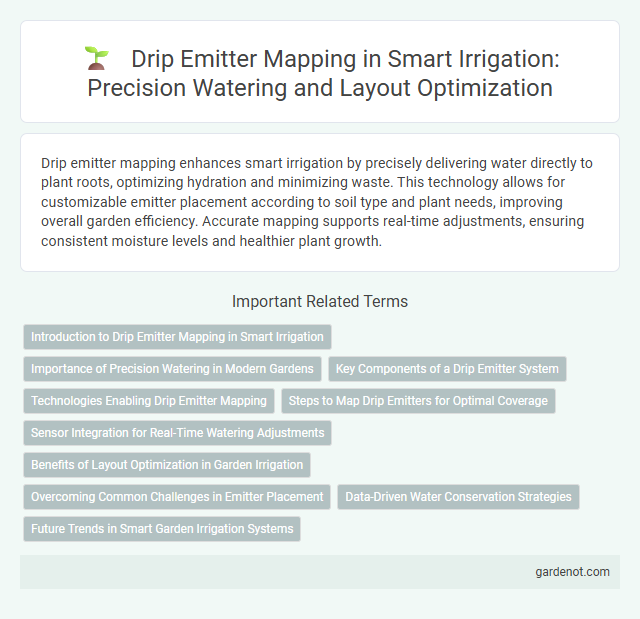Drip emitter mapping enhances smart irrigation by precisely delivering water directly to plant roots, optimizing hydration and minimizing waste. This technology allows for customizable emitter placement according to soil type and plant needs, improving overall garden efficiency. Accurate mapping supports real-time adjustments, ensuring consistent moisture levels and healthier plant growth.
Introduction to Drip Emitter Mapping in Smart Irrigation
Drip emitter mapping is a critical process in smart irrigation systems that ensures precise water delivery by mapping the location and flow rate of each emitter. This technology enhances water efficiency by tailoring irrigation schedules based on the exact needs of different zones within a landscape. Accurate emitter mapping reduces water waste and promotes healthier plant growth by preventing overwatering or underwatering.
Importance of Precision Watering in Modern Gardens
Drip emitter mapping enables precision watering by delivering exact amounts of water directly to plant roots, minimizing waste and enhancing plant health. Accurate emitter placement in modern gardens ensures optimal irrigation efficiency, reduces runoff, and conserves water resources. This technology supports sustainable gardening practices by promoting uniform moisture distribution tailored to diverse plant needs.
Key Components of a Drip Emitter System
Drip emitter mapping involves strategically placing emitters to ensure uniform water distribution, which is critical for maximizing irrigation efficiency and minimizing water waste. Key components of a drip emitter system include the emitter itself, tubing or lateral lines, pressure regulators, filters, and connectors; each part must be selected based on soil type, crop water requirements, and system pressure to optimize performance. Proper installation and maintenance of these components enhance root zone moisture control and contribute to sustainable water management in agriculture.
Technologies Enabling Drip Emitter Mapping
Technologies enabling drip emitter mapping include advanced GPS systems and IoT sensors that provide precise location data and real-time monitoring of water flow rates. Wireless communication protocols, such as LoRaWAN and Zigbee, facilitate data transmission from emitters to cloud-based platforms for analytics and maintenance scheduling. Machine learning algorithms analyze this data to optimize irrigation patterns, enhance water efficiency, and reduce operational costs.
Steps to Map Drip Emitters for Optimal Coverage
To map drip emitters for optimal coverage, first measure the irrigation area and create a detailed layout highlighting plant locations and root zones. Next, place emitters based on plant water requirements, emitter flow rates, and soil infiltration characteristics to ensure uniform water distribution. Finally, test the system under pressure, adjust emitter placement if needed, and document the layout for maintenance and future optimization.
Sensor Integration for Real-Time Watering Adjustments
Drip emitter mapping enhances smart irrigation by integrating moisture sensors that continuously monitor soil conditions, enabling real-time watering adjustments based on precise data. This sensor-driven approach minimizes water waste and ensures optimal plant hydration, improving agricultural efficiency and sustainability. Advanced systems utilize wireless sensor networks to transmit data instantly, allowing automated control of emitters for targeted irrigation.
Benefits of Layout Optimization in Garden Irrigation
Drip emitter mapping enhances garden irrigation by ensuring precise water distribution, minimizing water waste and promoting uniform soil moisture levels. Optimized layout reduces dry spots and oversaturated areas, fostering healthier plant growth and improving overall water efficiency. This targeted approach supports sustainable gardening, lowering water costs and conserving valuable resources.
Overcoming Common Challenges in Emitter Placement
Precise drip emitter mapping is crucial to overcoming common challenges in emitter placement, such as uneven water distribution and soil type variability. Utilizing advanced soil moisture sensors and spatial mapping technologies enhances the accuracy of emitter positioning to optimize water efficiency. Proper emitter spacing tailored to crop root zones ensures uniform irrigation, reducing water waste and promoting healthy plant growth.
Data-Driven Water Conservation Strategies
Drip emitter mapping leverages precise spatial data to optimize water distribution, significantly reducing waste in smart irrigation systems. By analyzing emitter locations and flow rates, data-driven water conservation strategies enable targeted watering schedules tailored to plant needs and soil conditions. This approach enhances irrigation efficiency, lowers water usage, and supports sustainable agricultural practices.
Future Trends in Smart Garden Irrigation Systems
Drip emitter mapping in smart garden irrigation systems is evolving with AI-driven sensors that analyze soil moisture, plant health, and weather patterns to deliver precise water amounts. Integration with IoT platforms enables real-time adjustments and predictive maintenance, reducing water waste and enhancing crop yield. Future trends emphasize machine learning algorithms optimizing emitter placement and flow rates tailored to diverse plant species and microclimates.
Drip emitter mapping Infographic

 gardenot.com
gardenot.com